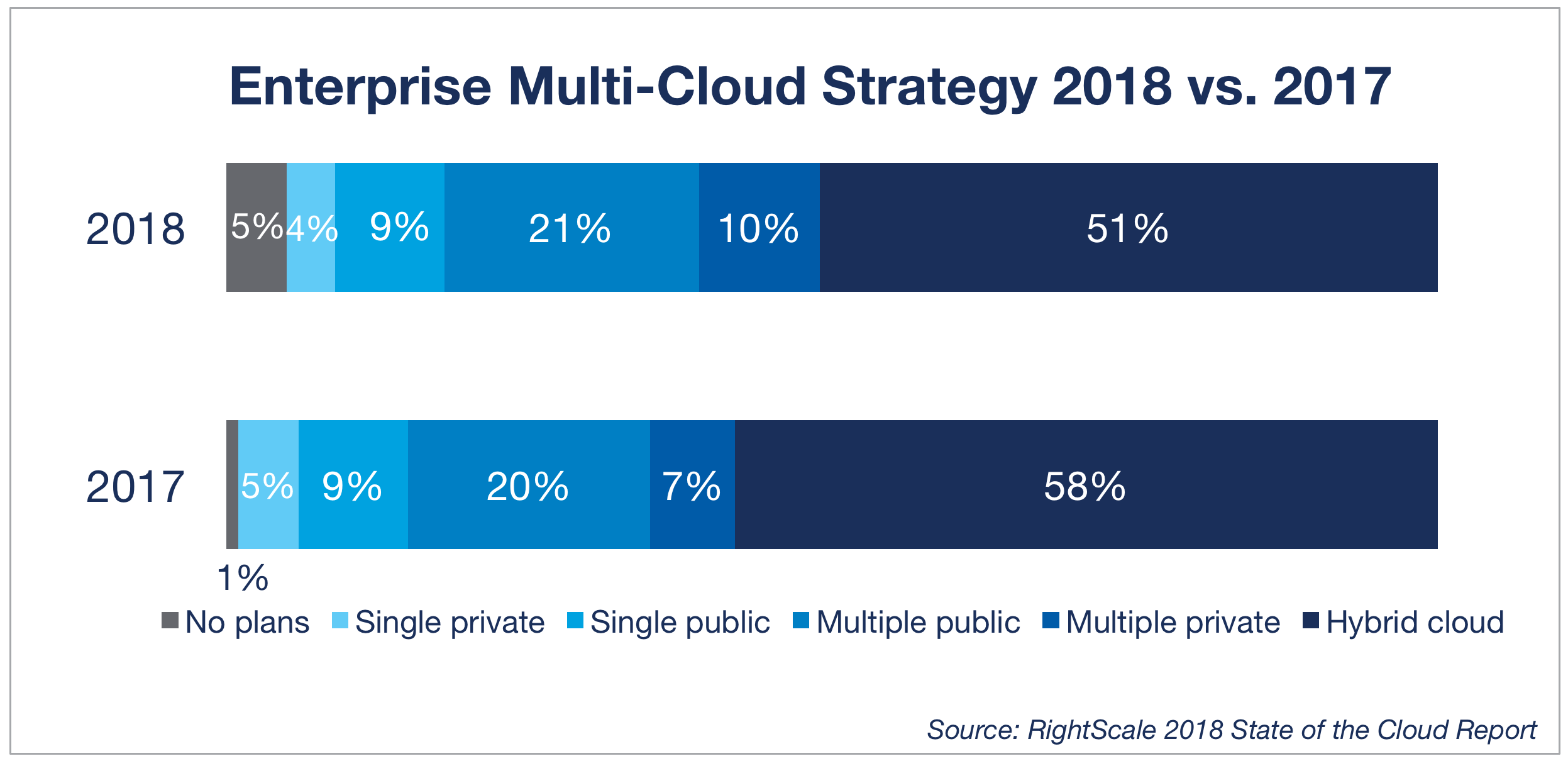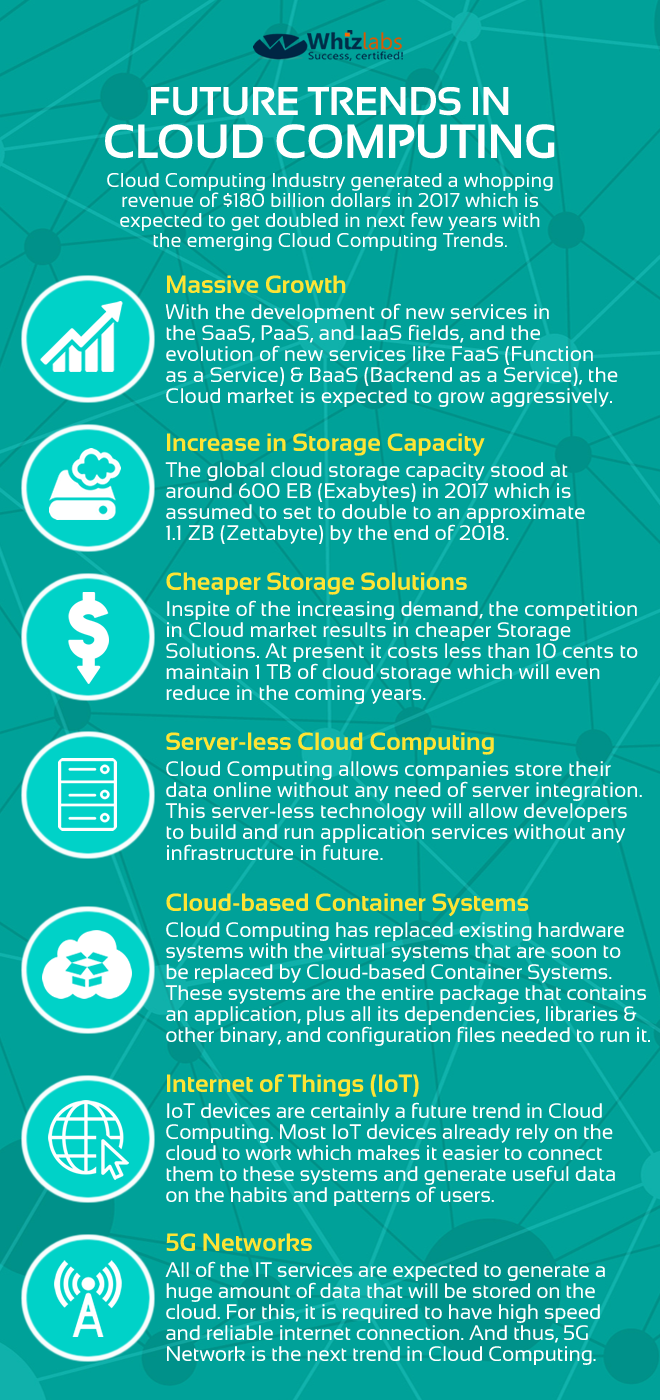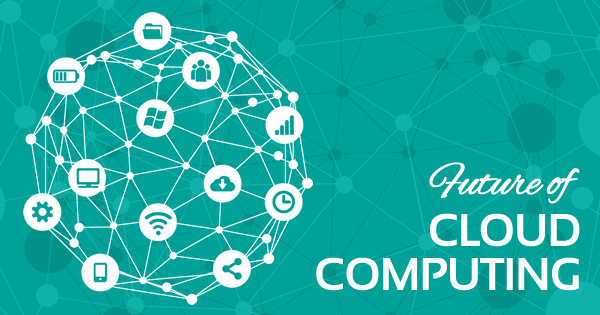In the past decade, Cloud Computing has gone from obscure service to multi-billion dollar corporations to become an integral part of the internet ecosystem. In this blog, we will discuss the journey of cloud computing and the latest cloud computing trends.
Planning to become a certified Cloud Computing professional? Check out our online courses and practice tests for Cloud Computing Certifications.
In it’s most crude form, Cloud Computing is the digital version of warehousing. Just like its offline counterpart, it was adopted and adapted to reduce the infrastructure costs that companies have to undertake in order to store and safeguard the personal as well as client data.
Cloud Computing service was first introduced in August 2006 when Amazon Web Services was launched with it’s very first Cloud Computing solution, Elastic Compute Cloud (EC2). This was soon followed by Google which launched its Google App Engine in 2008. Soon after, a research firm called Gartner started researching the benefits and opportunities presented by this new platform and thus the Cloud Computing Trends began.
Current Status of Cloud Computing Industry
Cloud Computing industry has undergone a number of Cloud Computing trends since its beginning. Based on this research and general market demands, the cloud computing industry was soon divided into various segments depending on the location and services offered by the cloud system.
Based on Cloud location:
Public Cloud
A Public Cloud is a cloud where the whole computing infrastructure is located on the premises of the cloud computing company that is offering the said service. The customer has no physical control over the infrastructure and has to share resources and hardware with other clients of the same service.
Private Cloud
Private Cloud means that the infrastructure for the network is only utilized by one customer or company even though the hardware is still located at a remote location. There is also the option of storing the system on-premise which is considerably more expensive but offers physical control over the infrastructure.

Hybrid Cloud
A Hybrid Cloud system combines multiple private and public clouds in the same system. In this service, a company can use a public cloud to interact with customers while keeping their own data secure on a private cloud, with the two clouds sharing different data, to complete the information while keeping them separate.
Community Cloud
A Community Cloud is used for sharing data between organizations. Some systems share data between a single entity and the public in general. An example of a community cloud can be any system that is run by the government of any country.
Amazon AWS, Microsoft Azure, and Google Cloud are the top three players in the Cloud market. Let’s have a comparison AWS vs Azure vs Google to find which cloud service provider you should adopt.
Based on Cloud Service:
IaaS (Infrastructure-as-a-Service)
IaaS involves offering storage solutions using data storage disks and virtual servers etc. You can only access or delete the data. A few of the major players involved in Infrastructure-as-a-Service (IaaS) service are Amazon, Rackspace, Flexiscale etc.
PaaS (Platform-as-a-Service)
PaaS based cloud services offer a development platform, which includes an operating system, programming language, database, and web server. This means clients can create their own custom cloud experiences based on the role of the service. Examples of PaaS systems are Google App Engine, Microsoft Azure, Salesforce etc.
SaaS (Software-as-a-Service)
SaaS services are developed by the companies offering them. All a customer needs to do is access them on a pay-per-use basis, which is far cheaper than creating your own. Some of these services are even offered for free to customers. Examples of such services include popular applications such as Gmail, Google Docs, NetSuite etc.
All of these when combined create the Worldwide Cloud Computing Industry which generates a whopping $180 billion dollars revenue for the year 2017. The cloud market, in general, spent over $80 billion on hardware and software alone, as it is anticipated that this revenue will double in the next few years, and all the major players want to be prepared to take advantage of the new Cloud Computing Trends in 2020.
Are you a fresher who is more interested to learn about Cloud Computing? Go through this Introduction to Cloud Computing and boost your Cloud knowledge.
Latest Cloud Computing Trends in 2020
The Cloud Computing industry with continuous growth is arising with a number of Cloud Computing trends. The Cloud Trends that we are going to mention below are the combination of new and old practices that have changed the way the industries operate. Let’s have a look at some of them now:
Massive Growth
This is more one of the Cloud Computing Trends 2020 which has just carried over to 2020. With the development of new services in the SaaS, PaaS and IaaS fields, and the evolution of new services such as function as a service (FaaS) and backend as a service (BaaS), the Cloud market is expected to grow aggressively. SaaS alone is expected to grow at 18% CAGR. PaaS has already been performing remarkably with an adoption rate of 32% in 2017 and expected to reach 56% by 2020. The IaaS market, even with its limited features is predicted to go over $17B in 2018. Even when related industry shows a definite slowdown, the future of the cloud computing market is definitely towards growth.
Increase in Storage Capacity
Another aspect of the growth-related cloud computing trends is the increase in storage capacity. In 2017 alone, the global cloud storage capacity stood at around 600 EB (Exabytes). We can certainly expect this to become one of the Cloud Computing Trends 2020, as the capacity is set to double to approximate 1.1 ZB (Zettabyte) by the end of 2018. Regular people are boosting these numbers thanks to their increased sharing of personal information online via services like Google Drive and Dropbox.
Cheaper Storage Solutions
The Cloud Computing Industry is going through a lot of changes. Massive Growth and Cheaper Prices were two of the main Cloud Computing Trends 2017. Usually, when demand increases, the price also increases, but since there is so much competition in the market today it seems that the prices are continuing to fall; thanks to so much investment in storage capacity increase. To put this in context, at present it costs less than 10 cents to maintain 1 TB of cloud storage. This price dive has given companies the ability to offer ridiculously cheap cloud storage solutions, which is, in turn, driving the growth further.
Also Read: Best Cloud Computing Certifications in 2020
Server-less Cloud Computing
When cloud computing first became popular, the entire ecosystem had to include servers in their processing as they were the places where data was initially stored. But now that most companies store their data online, there is no need for server integration. Which is why Server-Less Technology was developed that allows developers to build and run application services without any infrastructure. These new types of applications will definitely be one of the major Cloud Computing Trends in 2020, thanks to improving efficiency, less effort, and cost.
Startups have been the main driver of this Cloud Trend, as it lets them indulge in early cloud adoption, for better security and easier development. Even older organizations have started replacing their existing application to take advantage of this opportunity.
Cloud-Based Container Systems
It is common for Cloud Computing Trends to replace existing hardware-based systems, but it is not often that we see them taking out software-based systems as well. We are talking about virtual machines, which are being rapidly replaced by Cloud-Based Container Systems. These containers contain the entire package: an application, plus all its dependencies, libraries and other binaries, and configuration files needed to run it.
This package can be deployed quickly on different systems, irrespective of their personal complexities. This is great for software and app developers who now don’t have to worry about the load of the entire software package that is required for the virtual machines to run as well as the time it will take for it to boot up. This makes the containers smaller and faster than virtual machines.
Some examples of commercial container systems are, CoreOS’s Tectonic, Red Hat’s Open Shift Container Platform and Rancher Labs’ Rancher.

Internet of Things (IoT)
IoT devices are certainly a future trend in Cloud Computing. Most IoT devices already rely on the cloud to work which makes it easier to connect them to these systems and generate useful data on the habits and patterns of users.
This is why hundreds of companies have started upgrading their existing products to IoT connected devices such as household appliances, cars, and electronics. The data generated by this new generation of devices will boost the demand for cloud storage and cloud-based applications.
5G Networks
All of the IT services are expected to generate a huge amount of data that will be stored in the cloud. However, while handling this huge amounts of data, it is important that you have a reliable internet connection with great speed. LTE as an internet standard has already reached its limits, which is why the world is now looking towards 5G.
5G networks are being tested in various parts of the world. With the increased adoption of this new standard of internet speed, we will also enter a new phase for Cloud-based services, especially in developing countries like India, where more than 90% of internet activity is handled through mobile devices.
Big Data and Cloud computing are two mainstream technologies of the IT world. Let’s find out how Big Data and Cloud Computing makes a perfect combination together.
Final Words
So, you have reached the end! These are some of the Cloud Computing Trends for 2018-19 that we are really excited about seeing come true in the coming year. There are a lot of factors that can still affect the actual impact of these cloud computing trends, but we expect them to still be the driving force behind the cloud computing ecosystem.
With the regular growth and upcoming Cloud Computing Trends, the new opportunities are arising for the cloud professionals. Whizlabs is aimed to help professionals to get one level up in their careers. Thus, Whizlabs helps you prepare for a wide range of Cloud Computing Certifications offered by various cloud services providers such as AWS, Google, Azure, and Salesforce.
Prepare with Whizlabs online courses and practice tests and move towards a bright Cloud Career.
New to the Cloud Computing Platform? Just share your query with us in the comment section or just submit here, we’ll be happy to assist you in your Cloud Career.
- Top 20 Questions To Prepare For Certified Kubernetes Administrator Exam - August 16, 2024
- 10 AWS Services to Master for the AWS Developer Associate Exam - August 14, 2024
- Exam Tips for AWS Machine Learning Specialty Certification - August 7, 2024
- Best 15+ AWS Developer Associate hands-on labs in 2024 - July 24, 2024
- Containers vs Virtual Machines: Differences You Should Know - June 24, 2024
- Databricks Launched World’s Most Capable Large Language Model (LLM) - April 26, 2024
- What are the storage options available in Microsoft Azure? - March 14, 2024
- User’s Guide to Getting Started with Google Kubernetes Engine - March 1, 2024


Such an interesting and informative article! With the advent of the internet, technology seems to be evolving at a very rapid rate. Today, cloud computing has brought us excellent solutions for a variety of business needs. One of the key uses being the storage of sensitive information. Make sure that when you get your business documents digitized, you only do so with the most reliable service provider, who will ensure secure cloud storage as well as secure destruction of the physical copies.
This is such an informative article. Cloud computing is essential for every business and organization. In the future, cloud support will become a trend and bring a boost to the IT sector.
This is so helpful. Cloud computing technologies are very essential in our day to day activity.
Thank you for giving such an amazing information as this cleared many things about cloud computing.
Great article on cloud computing trends